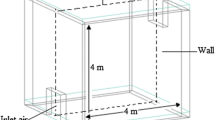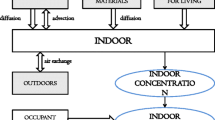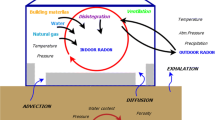Abstract
Simple mathematical ways of calculating the radon concentrations in walls and ground are presented. The methods exploit Fick’s second law in describing radon diffusion inside walls and ground. For both cases, a 1-dimension diffusion is adopted, with including advection in the ground case. The obtained forms fit the experimental data. Radon concentration inside a wall is employed to assess the decreased indoor gamma absorbed-dose rate from walls due to radon release. For describing radon diffusion through a building material sample, a 3-dimension diffusion is treated. Radon exhalation rates are suggested to be calculated from walls rather than building material samples.








Similar content being viewed by others
References
Druzhinin V, Sinitsky MY, Larionov AV, Volobaev VP, Minina VI, Golovina TA (2015) Assessing the level of chromosome aberrations in peripheral blood lymphocytes in long-term resident children under conditions of high exposure to radon and its decay products. Mutagenesis 50(5):677–683
A citizen’s guide to radon, United States Environmental Protection Agency. https://www.epa.gov/. Accessed 14 May 2019
Tong J, Qin L, Cao Y, Li J, Zhang J, Nie J, An Y (2012) Environmental radon exposure and childhood leukemia. J Toxicol Environ Health 15(5):332–347
Al-Zoughool M, Krewski D (2009) Health effects of radon: a review of the literature. Int J Radiat Biol 85:57–69
Bochicchio F (2005) Radon epidemiology and nuclear track detectors: methods, results and perspectives. Radiat Meas 40:177–190
Puskin JS (2003) Smoking as a confounder in ecologic correlations of cancer mortality rates with average county radon levels. Health Phys 84:526–532
Stoulos S, Manolopoulou M, Papastefanou C (2003) Assessment of natural radiation exposure and radon exhalation from building materials in Greece. J Environ Radioact 69:225–240
Cohen BL (1995) Test of the linear no-threshold theory of radiation carcinogenesis for inhaled radon decay products. Health Phys 68:157–174
Communities European, Luxembourg (1990) Commission recommendation on the protection of the public against indoor exposure to radon (90/143/Euratom). Off J Eur Comm L80:26–28
Keller G, Hoffmann B, Feigenspan T (2001) Radon permeability and radon exhalation of building materials. Sci Total Environ 272:85–89
Cozmuta I (2001) Radon generation and transport: a journey through matter. Ph.D. thesis
Kovler K, Perevalov A, Steiner V, Rabkin E (2004) Determination of the radon diffusion length in building materials using electrets and activated carbon. Health Phys 86:505–516
Hafez Y, Awad E (2016) Finite element modeling of radon distribution in natural soils of different geophysical regions. Cogent Phys 3:1254859
Ujic P, Celikovic I, Kandic A, Vukanac I, Durasevic M, Dragosavac D, Zunic Z (2010) Internal exposure from building materials exhaling 222Rn and 220Rn as compared to external exposure due to their natural radioactivity content. Appl Radiat Isot 68:201–206
Alghamdi AS, Aleissa KA (2014) Influences on indoor radon concentrations in Riyadh, Saudi Arabia. Radiat Meas 62:35–40
Li Y, Fan C, Xiang M, Liu P, Mu F, Meng Q, Wang W (2018) Short-term variations of indoor and outdoor radon concentrations in a typical semi-arid city of Northwest China. J Radioanal Nucl Chem 317(1):297–306
Ivanova K, Stojanovska Z, Kunovska B, Chobanova N, Badulin V, Benderev A (2019) Analysis of the spatial variation of indoor radon concentrations (national survey in Bulgaria). Environ Sci Pollut Res 26:6971–6979
Muntean LE, Cosma C, Cucos A (Dinu), Dicu T, Moldovan DV (2014) Assessment of annual and seasonal variation of indoor radon levels in dwelling houses from Alba County. Romania. Rom J Phys 59(1–2):163–171
United Nations Scientific Committee, New York (2000) The effects of atomic radiations sources: effects and risks of ionizing radiation
Orabi M (2017) Radon release and its simulated effect on radiation doses. Health Phys 112(3):294–299
Author information
Authors and Affiliations
Corresponding author
Ethics declarations
Conflict of interest
The author declares no conflict of interest.
Additional information
Publisher's Note
Springer Nature remains neutral with regard to jurisdictional claims in published maps and institutional affiliations.
Rights and permissions
About this article
Cite this article
Orabi, M. Simplified theoretical approaches to calculate radon concentrations in walls and ground. J Radioanal Nucl Chem 324, 569–578 (2020). https://doi.org/10.1007/s10967-020-07121-9
Received:
Published:
Issue Date:
DOI: https://doi.org/10.1007/s10967-020-07121-9




